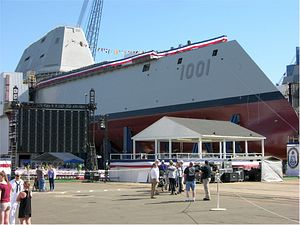The future USS Michael Monsoor, the second ship of the Zumwalt-class, the U.S. Navy’s biggest and technologically most advanced new class of guided-missile destroyers, had one of its two main turbine engines replaced after suffering damage to the turbine blades during acceptance trials earlier this year.
Although the engine still worked, the U.S. Navy decided to replace one of two Rolls-Royce MT30 Main Turbine Generators, a derivative of the Rolls-Royce Trent 800 that powers the Boeing 777 twin-engine jet airliner, following the discovery that a foreign object had damaged some of the engine’s blades.
Bath Irons Works had to custom build a rail system to remove the engine and replace it with a new one. “The number of twists and turns it had to go through represented a pretty interesting engineering evolution,” Bath Iron Works’ President Dirk Lesko was quoted as saying by the Associated Press.
The damage to the ship’s turbine blades was reportedly found in post-trials inspection. “The problem we had coming off of acceptance trials was actually the turbine blades…” Rear Admiral William Galinis said in July. “We found that after the sea trial through what we call a borescope inspection, where we actually put a visual and optical device inside the turbine to kind of look at this. And we determined that it was best to change that turbine out before we actually transited the ship to San Diego.”
The future USS Michael Monsoor is scheduled to depart for San Diego in November.
The damage is not expected to influence the installation and activation of the stealth destroyer’s combat systems, slated to take place following the Michael Monsoor’s transit in San Diego throughout 2018 and 2019. Activation work is expected to be concluded by 2020. The Monsoor will be commissioned in San Diego in January 2019. The new warship is expected to become operational in late 2020 or early 2021.
As I explained previously:
Zumwalt-class destroyers feature distinct wave-piercing tumblehome hulls and a stealth design meant to reduce the ship’s radar cross-section. The U.S. Navy accepted partial delivery of the Monsoor in late April following the completion of acceptance trials overseen by the U.S. Navy’s Board of Inspection and Survey — the service’s principal entity inspecting and reporting on a ship’s readiness for active duty operations — in February 2018.
The ship will be heavily armed, although it still lacks the proper ammo for its main guns:
Zumwalt-class destroyers are equipped with 80 MK57 vertical launch tubes, each capable of accommodating one to four SM-1, SM-2, and SM-6, or Tomahawk land-attack missiles. The stealth destroyers will also be armed with new long-range anti-ship missiles such as the Maritime Strike Tomahawk following a change of the mission requirements of the Zumwalt-class from a land-attack platform to surface warfare in November 2017.
The Zumwalt-class still lacks a projectile for its two main guns, with the Navy expected to select a replacement in the coming months.
U.S. defense contractor Raytheon Integrated Defense Systems has been awarded a $17.6 million contract for AN/SPY-3 (V)1 radar equipment work in support of the Zumwalt-class stealth destroyers, the U.S. Department of Defense announced on September 5.
































